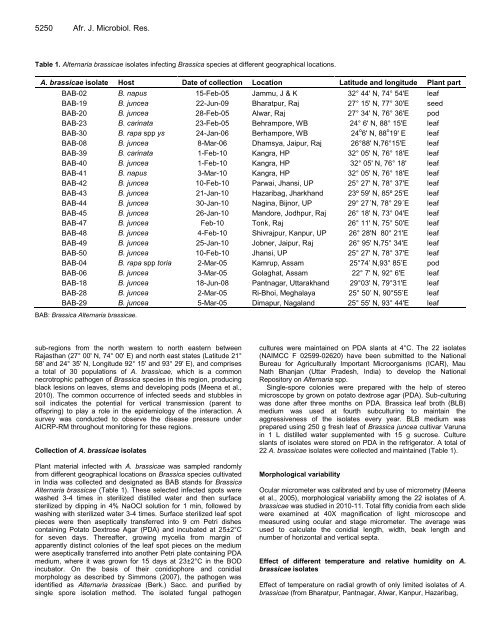Microbiology Research - Academic Journals
Microbiology Research - Academic Journals
Microbiology Research - Academic Journals
You also want an ePaper? Increase the reach of your titles
YUMPU automatically turns print PDFs into web optimized ePapers that Google loves.
5250 Afr. J. Microbiol. Res.<br />
Table 1. Alternaria brassicae isolates infecting Brassica species at different geographical locations.<br />
A. brassicae isolate Host Date of collection Location Latitude and longitude Plant part<br />
BAB-02 B. napus 15-Feb-05 Jammu, J & K 32° 44' N, 74° 54'E leaf<br />
BAB-19 B. juncea 22-Jun-09 Bharatpur, Raj 27° 15' N, 77° 30'E seed<br />
BAB-20 B. juncea 28-Feb-05 Alwar, Raj 27° 34' N, 76° 36'E pod<br />
BAB-23 B. carinata 23-Feb-05 Behrampore, WB 24° 6' N, 88° 15'E leaf<br />
BAB-30 B. rapa spp ys 24-Jan-06 Berhampore, WB 24 o 6' N, 88 o 19' E leaf<br />
BAB-08 B. juncea 8-Mar-06 Dhamsya, Jaipur, Raj 26°88' N,76°15'E leaf<br />
BAB-39 B. carinata 1-Feb-10 Kangra, HP 32° 05' N, 76° 18'E leaf<br />
BAB-40 B. juncea 1-Feb-10 Kangra, HP 32° 05' N, 76° 18' leaf<br />
BAB-41 B. napus 3-Mar-10 Kangra, HP 32° 05' N, 76° 18'E leaf<br />
BAB-42 B. juncea 10-Feb-10 Parwai, Jhansi, UP 25° 27' N, 78° 37'E leaf<br />
BAB-43 B. juncea 21-Jan-10 Hazaribag, Jharkhand 23º 59' N, 85º 25'E leaf<br />
BAB-44 B. juncea 30-Jan-10 Nagina, Bijnor, UP 29° 27´N, 78° 29´E leaf<br />
BAB-45 B. juncea 26-Jan-10 Mandore, Jodhpur, Raj 26° 18' N, 73° 04'E leaf<br />
BAB-47 B. juncea Feb-10 Tonk, Raj 26° 11' N, 75° 50'E leaf<br />
BAB-48 B. juncea 4-Feb-10 Shivrajpur, Kanpur, UP 26° 28'N 80° 21'E leaf<br />
BAB-49 B. juncea 25-Jan-10 Jobner, Jaipur, Raj 26° 95' N,75° 34'E leaf<br />
BAB-50 B. juncea 10-Feb-10 Jhansi, UP 25° 27' N, 78° 37'E leaf<br />
BAB-04 B. rapa spp toria 2-Mar-05 Kamrup, Assam 25°74‟ N,93° 85‟E pod<br />
BAB-06 B. juncea 3-Mar-05 Golaghat, Assam 22° 7' N, 92° 6'E leaf<br />
BAB-18 B. juncea 18-Jun-08 Pantnagar, Uttarakhand 29°03' N, 79°31'E leaf<br />
BAB-28 B. juncea 2-Mar-05 Ri-Bhoi, Meghalaya 25° 50‟ N, 90°55‟E leaf<br />
BAB-29 B. juncea 5-Mar-05 Dimapur, Nagaland 25° 55' N, 93° 44'E leaf<br />
BAB: Brassica Alternaria brassicae.<br />
sub-regions from the north western to north eastern between<br />
Rajasthan (27° 00' N, 74° 00' E) and north east states (Latitude 21°<br />
58' and 24° 35' N, Longitude 92° 15' and 93° 29' E), and comprises<br />
a total of 30 populations of A. brassicae, which is a common<br />
necrotrophic pathogen of Brassica species in this region, producing<br />
black lesions on leaves, stems and developing pods (Meena et al.,<br />
2010). The common occurrence of infected seeds and stubbles in<br />
soil indicates the potential for vertical transmission (parent to<br />
offspring) to play a role in the epidemiology of the interaction. A<br />
survey was conducted to observe the disease pressure under<br />
AICRP-RM throughout monitoring for these regions.<br />
Collection of A. brassicae isolates<br />
Plant material infected with A. brassicae was sampled randomly<br />
from different geographical locations on Brassica species cultivated<br />
in India was collected and designated as BAB stands for Brassica<br />
Alternaria brassicae (Table 1). These selected infected spots were<br />
washed 3-4 times in sterilized distilled water and then surface<br />
sterilized by dipping in 4% NaOCl solution for 1 min, followed by<br />
washing with sterilized water 3-4 times. Surface sterilized leaf spot<br />
pieces were then aseptically transferred into 9 cm Petri dishes<br />
containing Potato Dextrose Agar (PDA) and incubated at 25±2°C<br />
for seven days. Thereafter, growing mycelia from margin of<br />
apparently distinct colonies of the leaf spot pieces on the medium<br />
were aseptically transferred into another Petri plate containing PDA<br />
medium, where it was grown for 15 days at 23±2°C in the BOD<br />
incubator. On the basis of their conidiophore and conidial<br />
morphology as described by Simmons (2007), the pathogen was<br />
identified as Alternaria brassicae (Berk.) Sacc. and purified by<br />
single spore isolation method. The isolated fungal pathogen<br />
cultures were maintained on PDA slants at 4°C. The 22 isolates<br />
(NAIMCC F 02599-02620) have been submitted to the National<br />
Bureau for Agriculturally Important Microorganisms (ICAR), Mau<br />
Nath Bhanjan (Uttar Pradesh, India) to develop the National<br />
Repository on Alternaria spp.<br />
Single-spore colonies were prepared with the help of stereo<br />
microscope by grown on potato dextrose agar (PDA). Sub-culturing<br />
was done after three months on PDA. Brassica leaf broth (BLB)<br />
medium was used at fourth subculturing to maintain the<br />
aggressiveness of the isolates every year. BLB medium was<br />
prepared using 250 g fresh leaf of Brassica juncea cultivar Varuna<br />
in 1 L distilled water supplemented with 15 g sucrose. Culture<br />
slants of isolates were stored on PDA in the refrigerator. A total of<br />
22 A. brassicae isolates were collected and maintained (Table 1).<br />
Morphological variability<br />
Ocular micrometer was calibrated and by use of micrometry (Meena<br />
et al., 2005), morphological variability among the 22 isolates of A.<br />
brassicae was studied in 2010-11. Total fifty conidia from each slide<br />
were examined at 40X magnification of light microscope and<br />
measured using ocular and stage micrometer. The average was<br />
used to calculate the conidial length, width, beak length and<br />
number of horizontal and vertical septa.<br />
Effect of different temperature and relative humidity on A.<br />
brassicae isolates<br />
Effect of temperature on radial growth of only limited isolates of A.<br />
brassicae (from Bharatpur, Pantnagar, Alwar, Kanpur, Hazaribag,

















